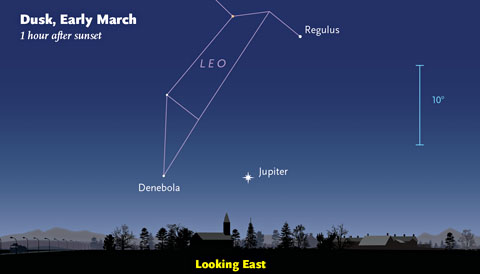After months of excitement in the predawn sky, the action is shifting to the evening. This month's astronomy podcast features Jupiter rising early and the stars of Orion anchoring an array of celestial sights.
March is a time of seasonal transition, celestially speaking. The March equinox, which marks the start of spring in the Northern Hemisphere and of autumn in the Southern Hemisphere, occurs this year on the 20th at 12:30 a.m. Eastern Time (9:30 p.m. Pacific Time on the 19th).
Soon after sunset you'll find the first star of the evening: brilliant Sirius, the night sky's brightest star. Anytime during the first days of March, make a note of the horizon point directly below this beacon at 8 p.m. — that’s very nearly due south.
Look to the upper right of Sirius to spot Orion, the Hunter. Its two brightest stars are white Rigel, which marks his lower-right foot, and orange-red Betelgeuse, his upper-left armpit. Midway between them, look for the three-star row of Orion’s Belt. Look to the left of Betelgeuse for the bright star Procyon. These two stars, together with Sirius, form a big, equilateral triangle — known as the Winter Triangle to skywatchers.

Sky & Telescope diagram
Let your eyes drift past Procyon over to the eastern horizon. There you’ll see a “star” that outshines Betelgeuse, Rigel, and even Sirius. But that’s no star — it’s Jupiter. The King of Planets comes to opposition, that is, opposite the Sun in the sky, on March 8th.
To get a personally guided tour of these night-sky sights and others overhead during March, download our 7½-minute-long astronomy podcast below.
Podcast: Play in new window | Download
Subscribe: Apple Podcasts | Google Podcasts | Spotify | Email | RSS | More
There's no better guide to what's going on in nighttime sky than SkyWatch 2016, a yearlong guide prepared by the editors of Sky & Telescope magazine.
 2
2
Comments
February 27, 2016 at 5:02 pm
Just wanted to say thank you to Kelly, for his many years of service at S&T - something like 42 years! There are others I'd like to thank, as well, but for the moment... I remember when Kelly was doing Skyline, the phone astronomy news service; I probably called that number every day for the duration of that service!
You must be logged in to post a comment.
March 9, 2016 at 8:50 pm
Kelly Beatty,
Thanks for your podcast. Have been interested in astro-photography for the past 3 or 4 years. Have finally gotten myself a 4.5inch reflector with an iOptron Cube alt/azimuth auto tracker. Looking to buy an intermediate entry level camera for planets and deep sky objects. have picked the "Orion - StarShoot All-In-One Astrophotography Camera" http://telescopes.net/store/imaging/orion-starshoot-all-in-one-astrophotography-camera.html . Have found it new for as low as $349 with free shipping. Is this a good decision for me to finally start getting some decent deep sky images.
I have been using my fujifilm finepix 10megapixle 40mmx12xoptical zoom for all of my astro-photography attempts. Have had limited success with juipter and its moons and also the orion nebula.
Several Low Res Uploads
https://picasaweb.google.com/104586180195227771120/OrionAndJuipiter?authuser=0&feat=directlink
I'm Ready to move on to the next step. Any suggestions would be much appreciated. I know an Alt/Az mount is not ideal for long exposures but if i can get 30-60 seconds that is 26-56 more exposure time than i have now with a much smaller aperture and much lower f.stop
Thanks
Zane McElroy - Georgia, USA
You must be logged in to post a comment.
You must be logged in to post a comment.